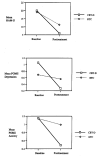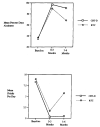Cognitive-behavioral treatment for depression in alcoholism
- PMID: 9337490
- PMCID: PMC1885208
- DOI: 10.1037//0022-006x.65.5.715
Cognitive-behavioral treatment for depression in alcoholism
Abstract
Alcoholics with depressive symptoms score > or = 10 on the Beck Depression Inventory (A.T. Beck, C. H. Ward, M. Mendelson, J. Mock, & J. Erbaugh, 1961) received 8 individual sessions of cognitive-behavioral treatment for depression (CBT-D, n = 19) or a relaxation training control (RTC; n = 16) plus standard alcohol treatment. CBT-D patients had greater reductions in somatic depressive symptoms and depressed and anxious mood than RTC patients during treatment. Patients receiving CBT-D had a greater percentage of days abstinent but not greater overall abstinence or fewer drinks per day during the first 3-month follow-up. However, between the 3- and 6-month follow-ups, CBT-D patients had significantly better alcohol use outcomes on total abstinence (47% vs. 13%), percent days abstinent (90.5% vs. 68.3%), and drinks per day (0.46 vs. 5.71). Theoretical and clinical implications of using CBT-D in alcohol treatment are discussed.
Figures



References
-
- American Psychiatric Association . Diagnostic and statistical manual of mental disorders. 3rd ed. Author; Washington, DC: 1987.
-
- Annis HM. Situational Confidence Questionnaire. Addiction Research Foundation; Toronto, Ontario, Canada: 1988.
-
- Babor TF, Stephans RS, Marian GA. Verbal report methods in clinical research on alcoholism: Response bias and its minimization. Journal of Studies on Alcohol. 1987;48:410–424. - PubMed
-
- Baekland F, Lundwall L, Shanahan TJ. Correlates of patient attrition in the outpatient treatment of alcoholism. The Journal of Nervous and Mental Disease. 1973;157:99–107. - PubMed
-
- Baron RM, Kenny DA. The moderator-mediator variable distinction in social psychological research: Conceptual, strategic, and statistical considerations. Journal of Personality and Social Psychology. 1986;51:1173–1182. - PubMed

